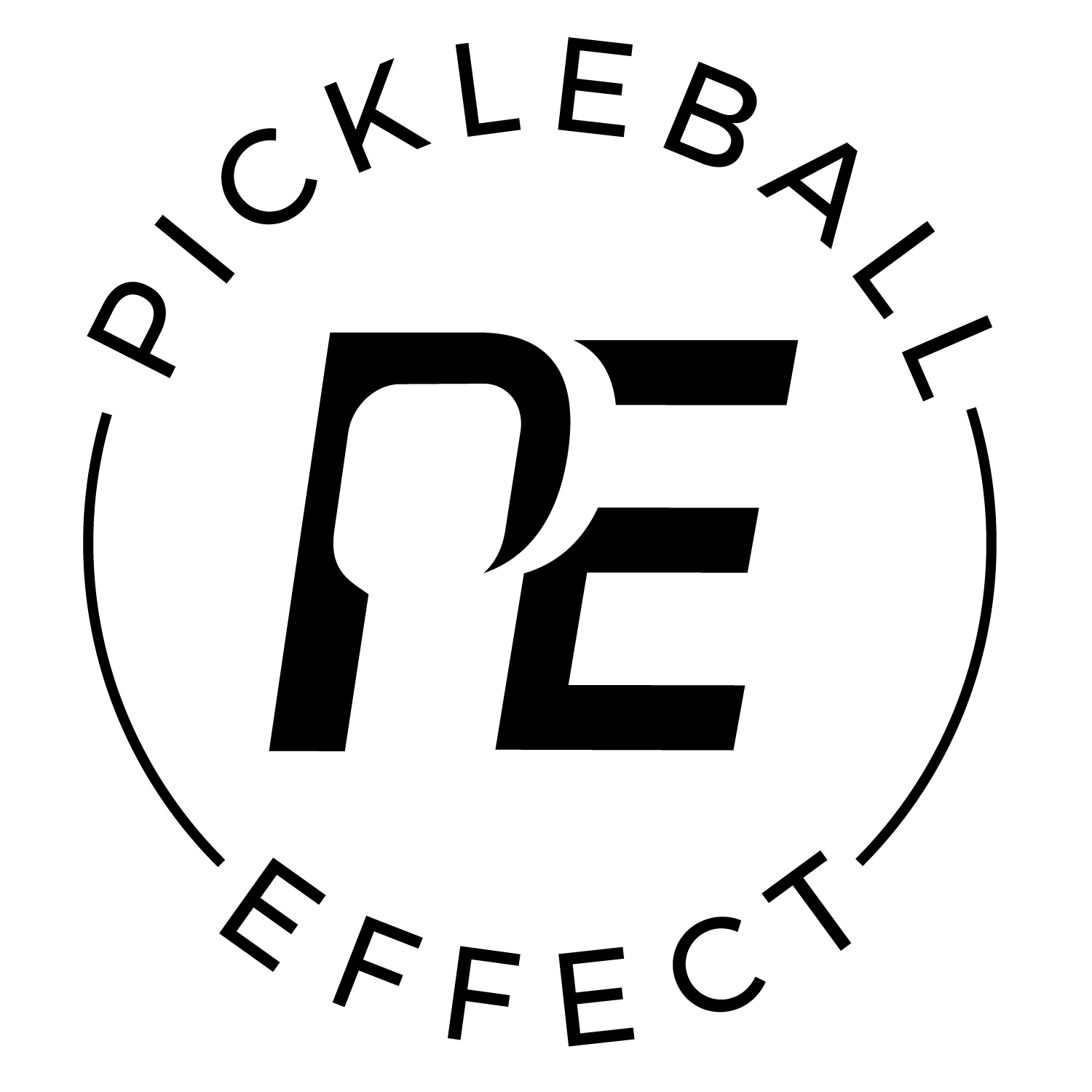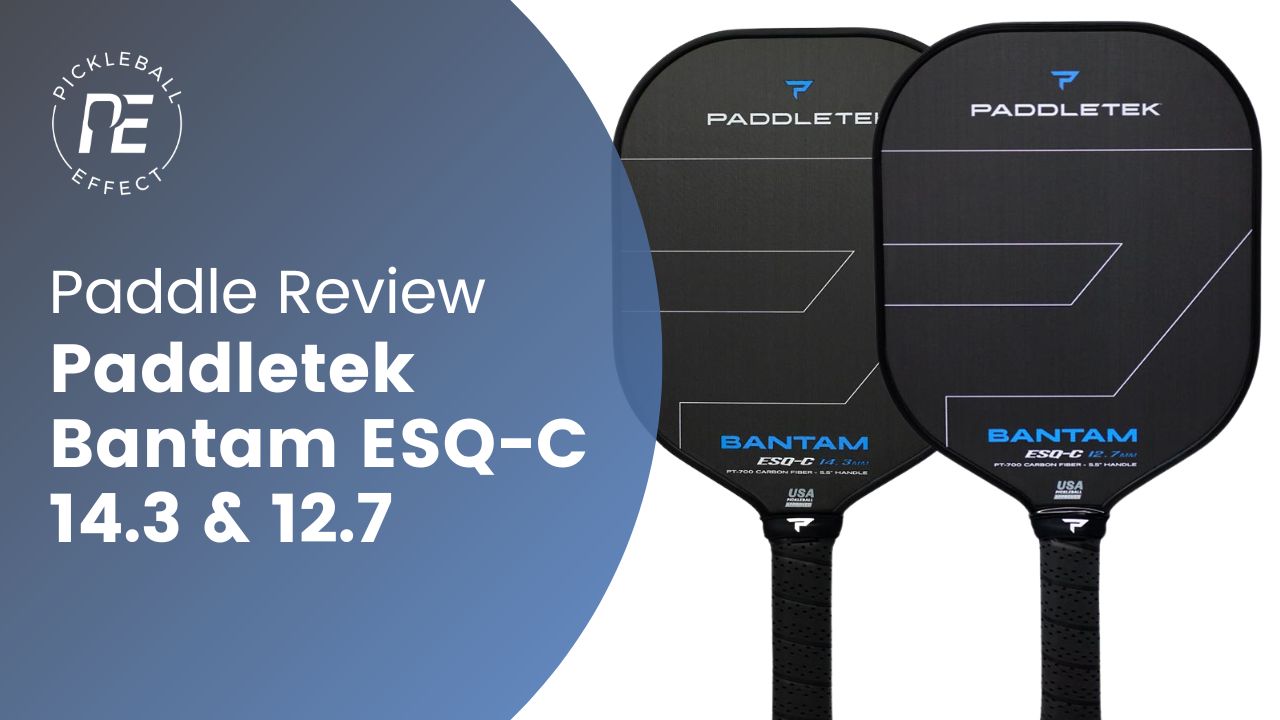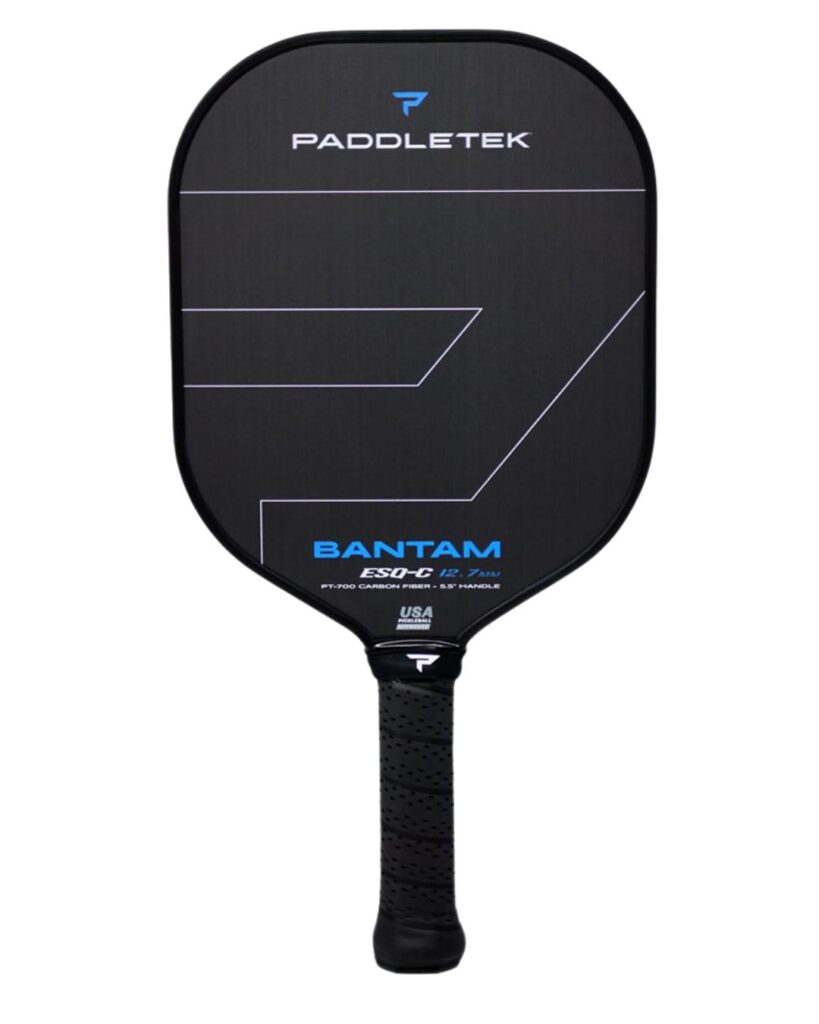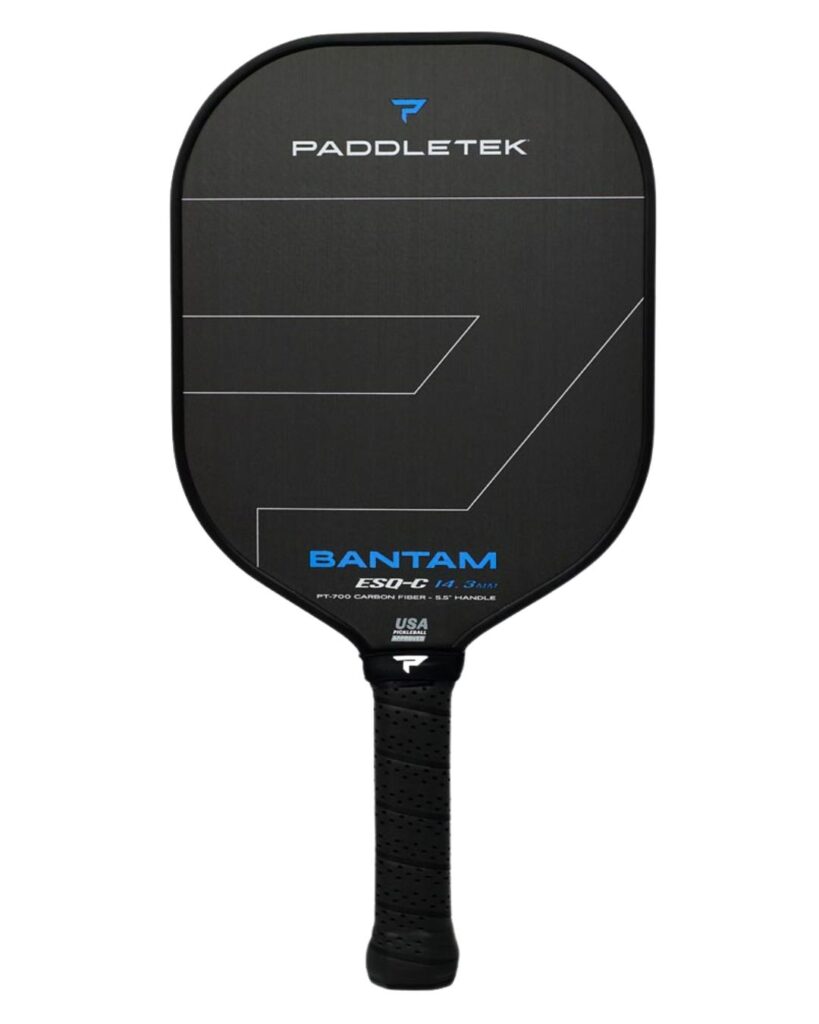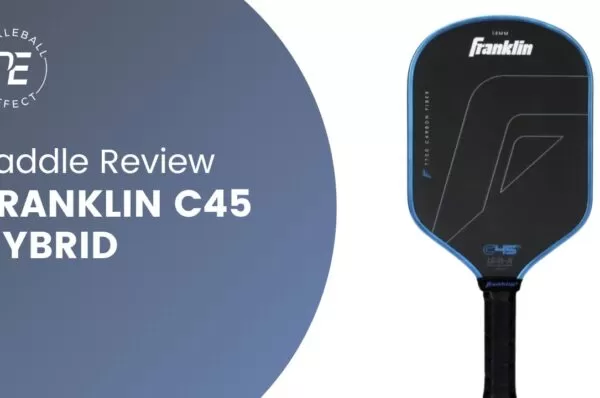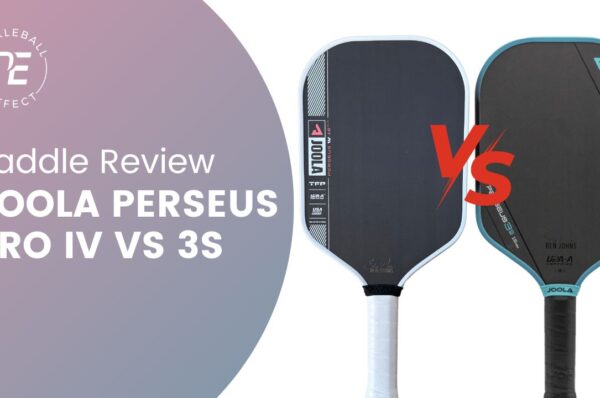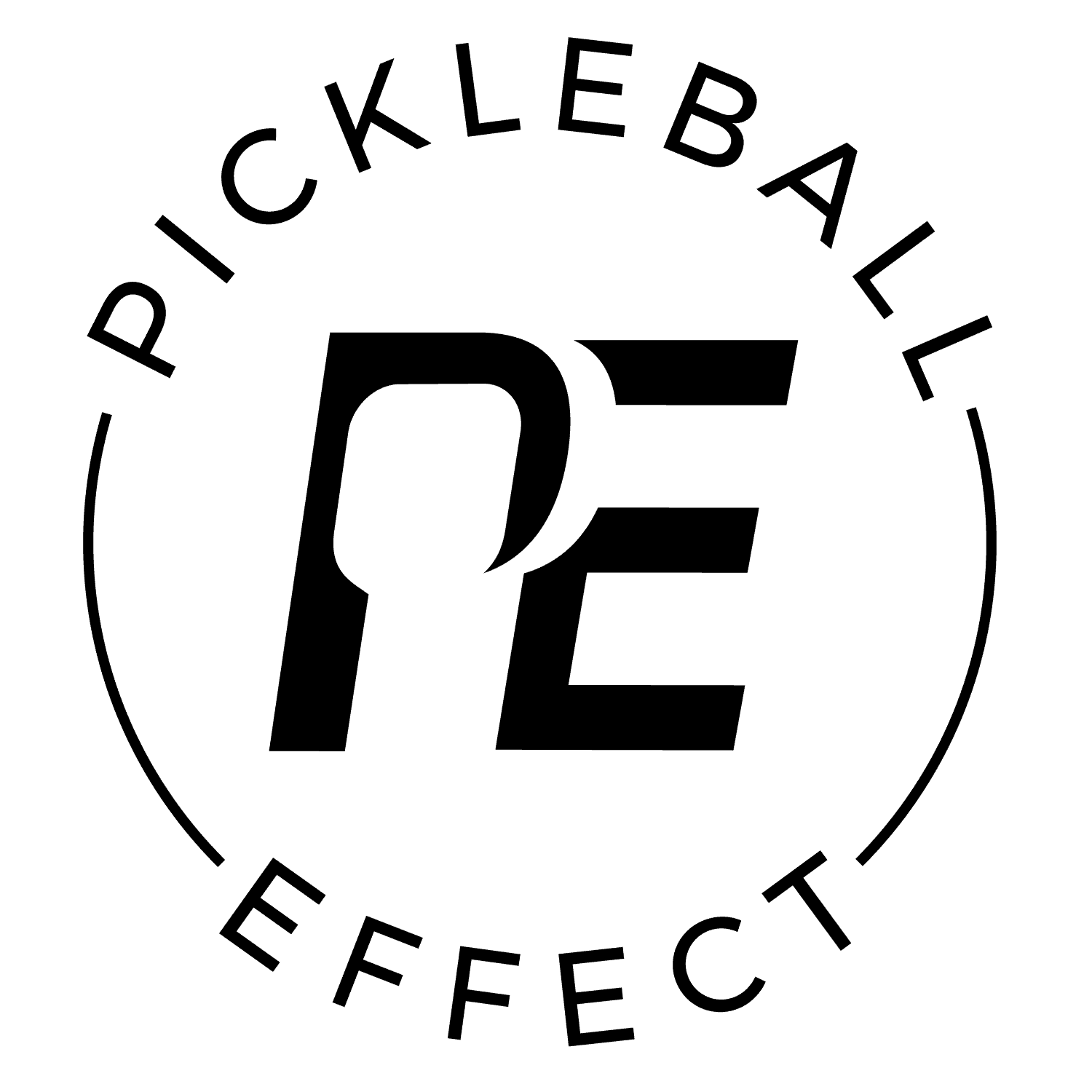The Paddletek Bantam ESQ-C is a new standard paddle shape in Paddletek’s power oriented Bantam series and is available in a 12.7mm and 14.3mm option. It’s similar in shape to the Bantam ALW-C but has a longer handle at 5.5″ and is a touch shorter and wider with the dimensions of 15.9″ x 8″.
Paddletek is one of the original major paddle manufacturers but felt dormant for years until they started to gain popularity again mid 2024 with the release of their Bantam TKO-C paddles. Following the success of the TKO-C series, they made handle improvements to the Bantam ALW-C paddles and recently launched the new Bantam ESQ-C model on Oct 1, 2024. The ESQ-C appears to share many similarities with the ALW-C paddles. The sudden appearance of this paddle raises questions about its origins and the company’s strategic direction. However, the paddle is different from the ALW-C paddle and the story behind it is great. I have the story for you and I share my review of how the paddles play which turned out to be really good. They offer a unique combination of power, pop, and extreme maneuverability.
Table of Contents
The Story Behind the Bantam ESQ-C
The ESQ-C is the brain child of Paddletek pro Andrea Koop. Andrea has been playing on the professional tour for many years and has been sponsored by Paddletek for just as long. She played with Paddletek’s control style Tempest Wave paddles for a long time but as the game got faster she needed more power and wanted to change paddles to Paddletek’s power style Bantam series. There was just one problem. Andrea liked standard shaped paddles and was a heavy two handed backhand user and the only standard shaped paddle Paddletek had was the ALW paddle and it had a very short handle under 5″ at the time.
Andrea convinced Paddletek to create a new paddle shape in the Bantam series just for her. They called it the ESQ-C. She was the only one that used it for a while but people began to notice it and ask how they could get one. She would send them to her contact at Paddletek for special orders. These special orders grew overtime and then paddle reviewers like me and others began to notice too and it was talked about in various podcasts. These special orders continued to grow until Paddletek couldn’t ignore them anymore and decided to just release the paddle to the public. I’m glad they did because I agreed with Andrea and thought a longer handle standard shaped paddle in their Bantam series would be awesome. And it turns out I was right because the paddles are really good!
Bantam ESQ-C 12.7 Review
- Static Weight: 7.6-7.9 oz avg
- Swingweight: 104-07 (very low)
- Twistweight: 6.6-6.9 (high)
- Spin RPMs: 2071 (very high)
- Length x Width: 15.9″ x 8″ (standard)
- Face: Unidirectional raw carbon fiber
- Grip Circumference: 4.25″
- Handle Length: 5.5″
- Core: 12.7mm Polypropylene Honeycomb
- Special Features: Targeted weight added to sides
- Paddle Type: Power
- Price: $250 ($225 with code 10EFFECT until Nov 15, 2024)
- Warranty: 30 day love it or return it policy and a limited lifetime warranty
(Get 10% off with the discount code 10EFFECT from either website)
Performance Summary
The ESQ-C 12.7 is extremely lightweight, very poppy, has above average power, big spin and a good sweet spot. This is a rare combination of paddle characteristics and a very good combination for players who like to be aggressive at the net.
There aren’t many standard shaped paddles that come with some power and pop. But the ESQ-C 12.7 delivers in this department and is one of only a few standard shaped paddles I’d categorize as a power paddle. In my tests, it ranked in the top 10% for pop and the top 30% for power among the 150+ paddles I’ve evaluated.
It’s rare to find a standard-shaped power paddle, let alone one that is also this lightweight with an average swingweight of 106. This combo of being ultra lightweight and high in pop makes it one of the best offensive paddles I’ve ever used at the net. You can get your paddle into position quickly on counters and you find the ball out in front of you more often in fast hands exchanges. But not only are you in better position more often, you also have the pop to put some pace on the ball and win those fast hand exchanges.
Control wise the paddle was surprisingly easy to hit drop shots with and slow the ball down from the baseline when you were under pressure but as you worked your way to the net the tricker to control it got because of its poppy nature. It had a good sweet spot though not oversized like many standard shaped paddles due to its lighter nature and thinner core. I added 3 inches of half gram per inch tungsten tape to each corner improve stability and plowthrough and I liked that set up. It felt a little flimsy straight out of the box because it’s so light but this set up minimized the total amount of weight added while still bumping the swingweight up to 111. Giving you more stability and power without ruining the fast nature of the paddle.
I also found that I didn’t hit serves or returns long as often as I would with other power paddles but resetting attacks and keeping your dinks down required more skill to execute. So it was this interesting balance that not every power paddle has. You have the freedom to swing more aggressively on serves, drives, and midcourt attacks compared to other power paddles, yet it still demands the extra attention to keep the ball low on resets and dinks.
The impact feel of the paddle was more pleasant than that of its elongated TKO-C counterparts. The wider nature of the head shape reduces some of the tension and gives you a more comfortable, less firm feel than the TKO-C. It still has that general hollowish, pingy, light feel the TKO-C had, just less pronounced.
Bantam ESQ-C 14.3 Review
- Static Weight: 7.6-7.9 oz avg
- Swingweight: 104-07 (very low)
- Twistweight: 6.6-6.9 (high)
- Spin RPMs: 2059 (very high)
- Length x Width: 15.9″ x 8″ (standard)
- Face: Unidirectional raw carbon fiber
- Grip Circumference: 4.5″
- Handle Length: 5.5″
- Core: 14.3mm Polypropylene Honeycomb
- Special Features: Targeted weight added to sides
- Paddle Type: All-Court
- Price: $250 ($225 with code 10EFFECT until Nov 15, 2024)
- Warranty: 30 day love it or return it policy and a limited lifetime warranty
(Get 10% off with the discount code 10EFFECT on either website until November 25, 2024.)
Performance Summary
The ESQ-C 14.3 is also very lightweight but is more stable and carries through the ball better than the 12.7 out of the box. Its power is a similar level as the 12.7 but its pop is toned down in comparison though still higher than most standard shaped paddles. It’s toned down enough that I would categorize it as an all-court paddle and not a power paddle. It’s still a nice addition to the standard shaped category because there aren’t many all-court style standard shaped paddles either.
The paddle still brings offense and improves your hand speed and counters at the net but with some added touch for resets and dinks. It was easier to connect with and control this paddle than the 12.7. The sweet spot felt good and was above average to nearly oversized. It was more plush feeling than the 12.7 and it’s elongated TKO-C 14.3 counterpart. Though it’s not your traditional plush feeling, something about the Paddletek Bantam paddles give them a unique feel that is more hollow, pingy, and light feeling at impact. Not an ugly or bad feel, just different from your typical paddle.
Because the ball didn’t jump off as quickly as the 12.7, it was easier to find angles on cross court speed ups and crosscourt dinks without flying the ball wide a few inches. It was just a little easier to play in general that way and required less precision than the 12.7.
The grip circumference of the 14.3 is blockier and thicker at 4.5″. It was uncomfortable to me and I preferred the octagonal 4.25″ circumference of the 12.7 model.
Comparison to Paddletek Bantam ALW-C
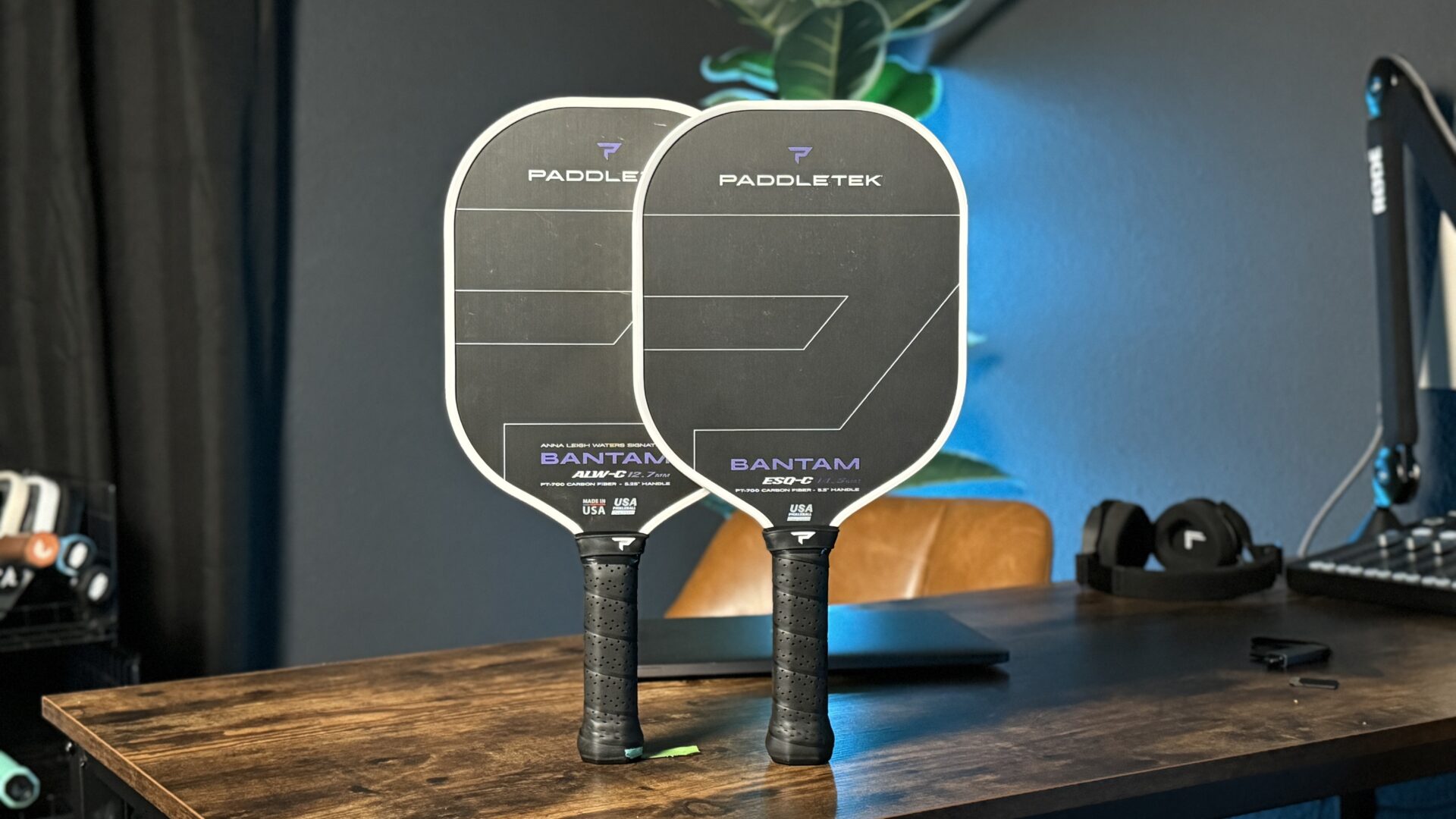
The ESQ-C was released about two weeks after Paddletek updated their similarly shaped Bantam ALW-C handle to be 5.25″ long from 4.8″. The Bantam ALW-C is the paddle women’s world number one player, Anna Leigh Waters, plays and is constructed the exact same way as the Bantam ESQ-C and has a very similar shape.
While there seems to be a lot of overlap and similarities between the two models there are subtle differences. The ALW-C model is a touch longer and narrower along with the .25″ shorter handle. The ALW-C is also a little lighter on average. That being said, when I was switching between both models it was tough to tell a difference in performance. However, because the face is a little bigger on the ESQ-C and the handle length is longer I preferred it over the ALW-C though picking between the two primarily comes down to handle length preference more than anything else.
Now here are some rankings of power, pop, control, forgiveness, and maneuverability for other popular power and all-court paddles in the standard or widebody shape category. Included in the lists are the Paddletek ESQ-Cs, JOOLA Scorpeus 3S 16mm, Ronbus Ripple R2, and the 11SIX24 Monarch All-Court 16mm. If you decide to get any of these paddles, my code 10EFFECT works on all their sites.
I did not include spin as part of the comparison charts because the spin on all these paddles is top-tier and shouldn’t impact your decision one way or another.
Market Comparison Charts
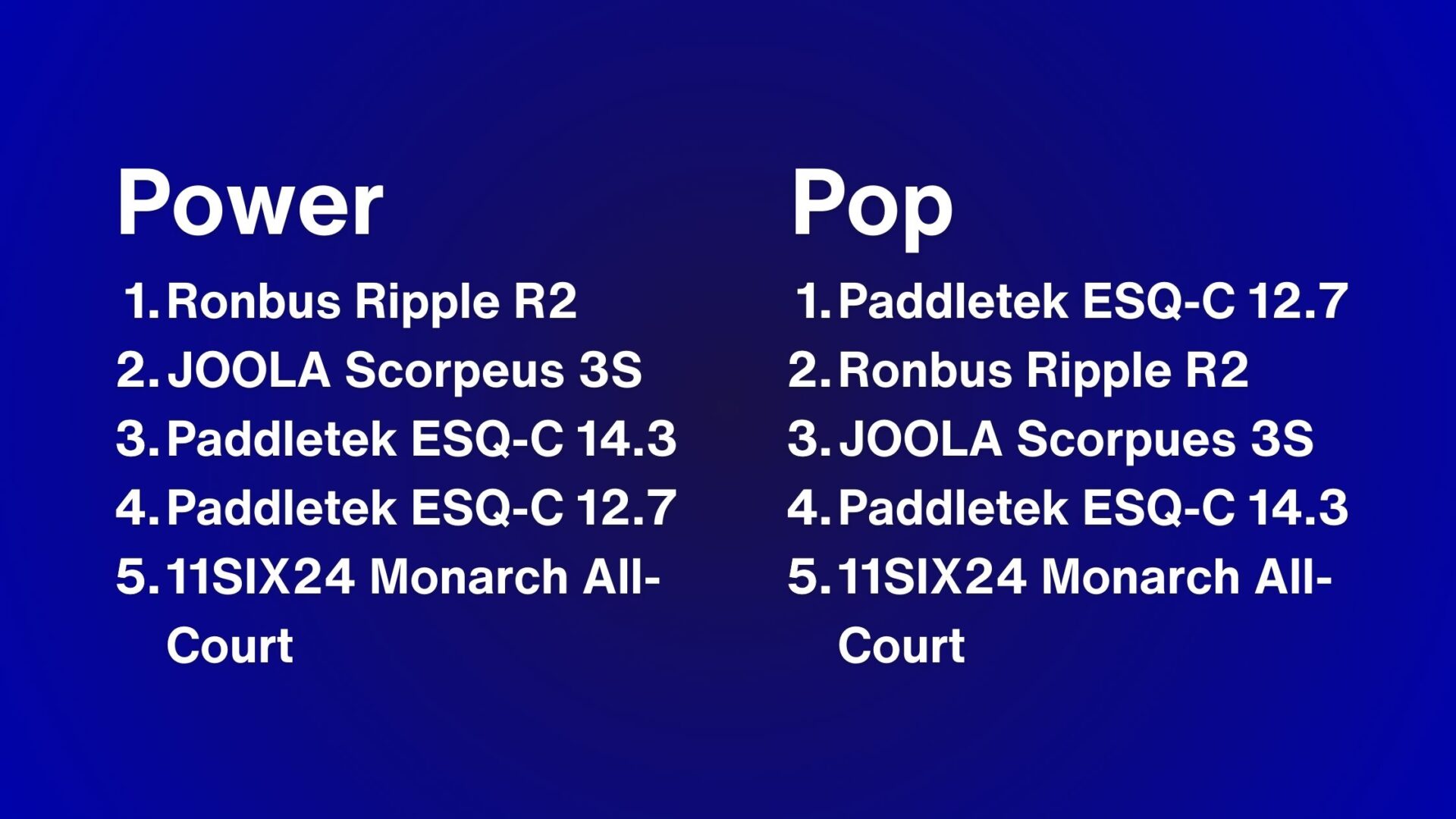
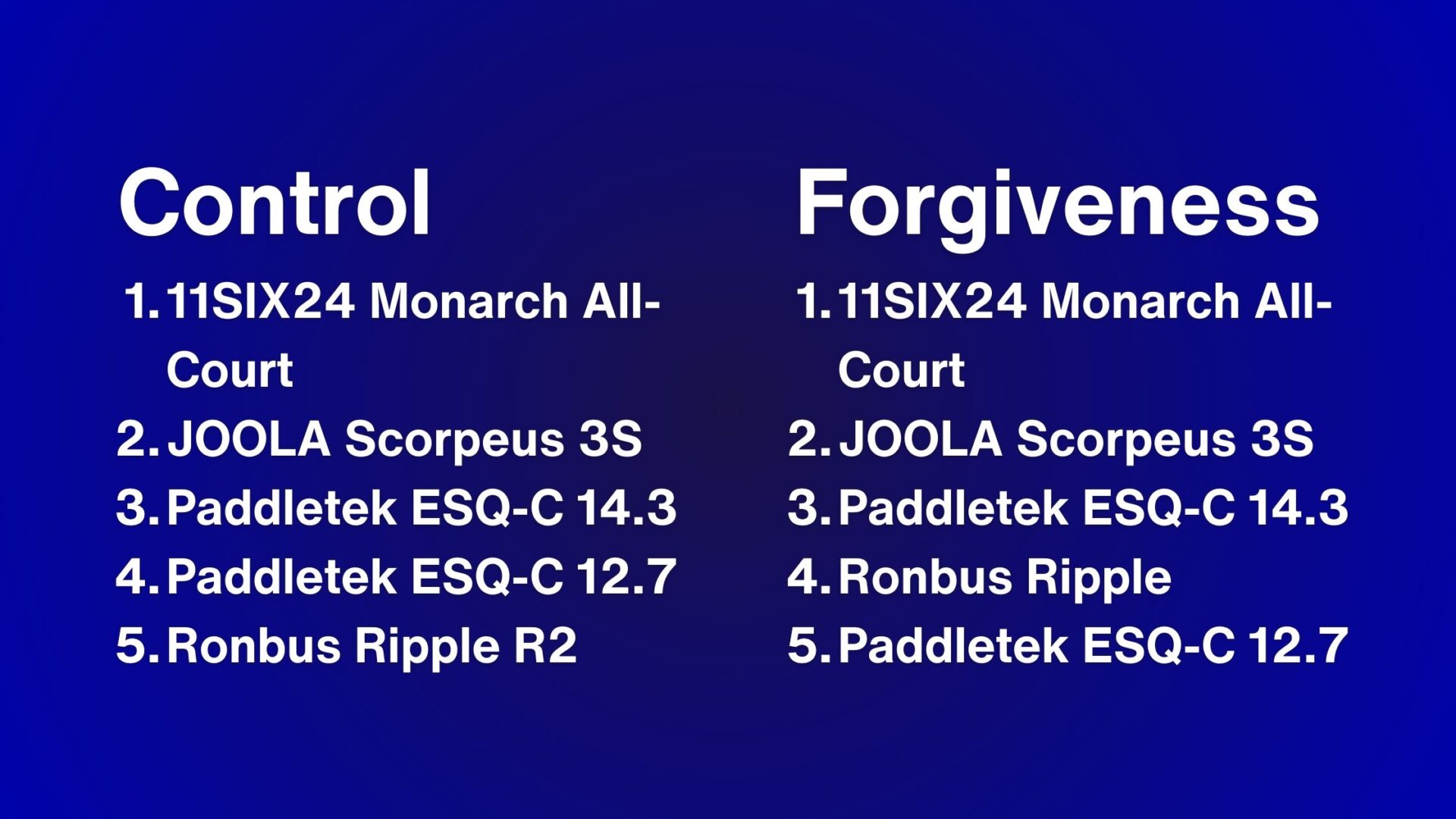
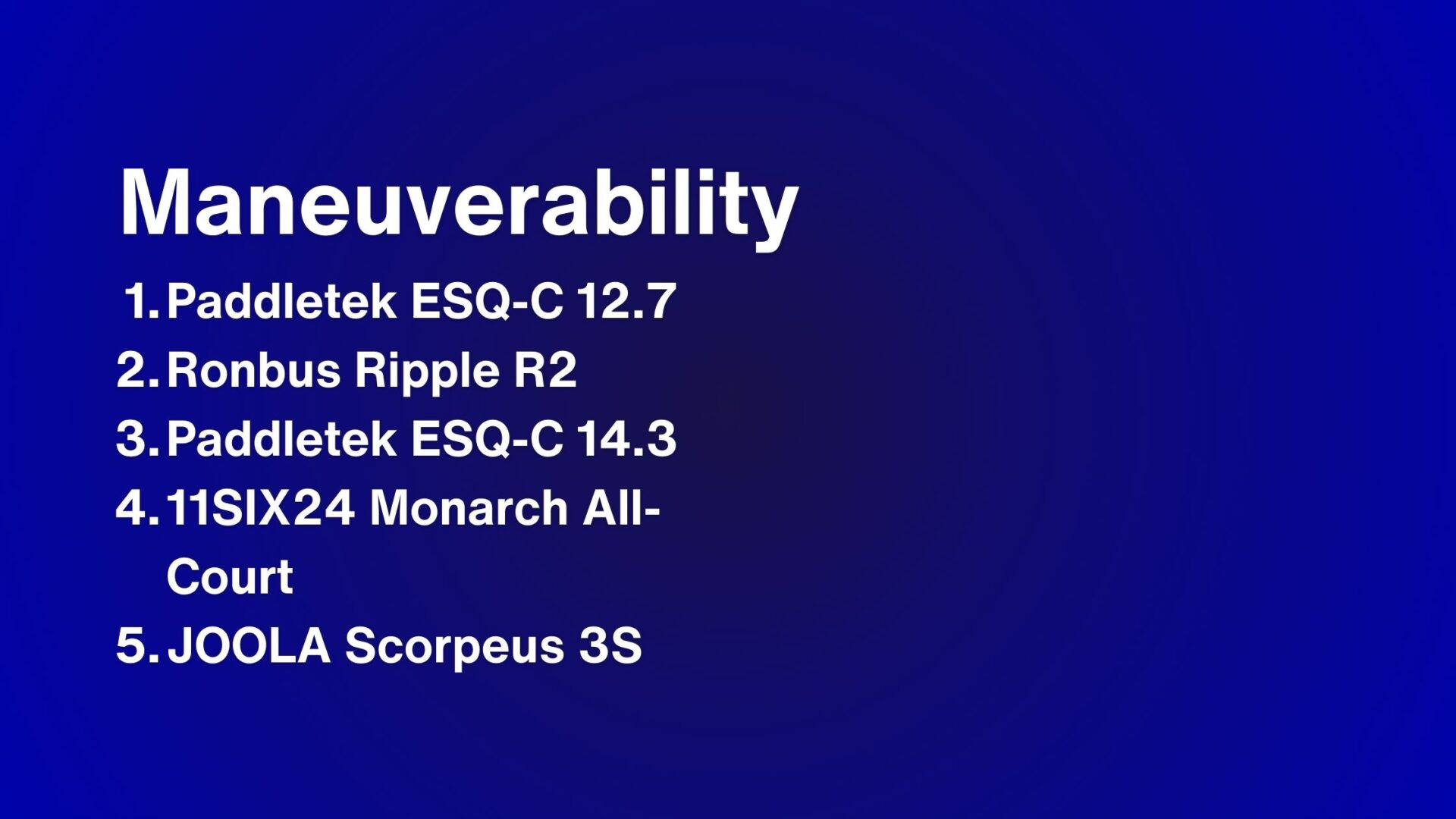
Cheaper Alternatives
I think the ESQ-C 12.7 is unique and doesn’t have a cheaper alternative. It’s combination of lighter weight, big pop, and medium power is uncommon. The only other paddle that compares is the Ronbus Ripple and it is also $250.
The ESQ-14.3 though is less unique and you can find some cheaper alternatives. The best one that is similar to it is the 11SIX24 Jelly Bean 14mm. It retails for $99 and only cost $90 with the code 10EFFECT on their website. I actually like the handle on the Jelly Bean more too, it’s not as thick. It produces a similar level of power and pop that’s all-court leaning power but achieves it with a little different tech that makes it a little stiffer compared to the 14.3 though it’s not harsh feeling.
My Recommendation
I anticipated interest in these paddles, so I played some games to gauge their performance when I first received them. Now I’m having a hard time putting them down and am strongly considering switching to the ESQ-C 12.7 and will be keeping it in my bag for competitive play when I’m not testing other paddles. As a higher level player that doesn’t have that natural transfer of power from paddle to ball, the extra pop on this paddle combined with its excellent maneuverability is a really nice combo to have and has noticeably improved my offensive ability at the net. I’m finding good contact with the ball on counters and am more competitive in hands battles. While my soft game is more challenging with it, I’m controlling the ball better than I was with the Bantam TKO-C models. I’ll keep dialing it in as more time goes.
If you’re like me and benefit from the combination of maneuverability and pop then you’ll like these. The only other paddle that competes as well here is the Ripple R2 though I think the Paddletek is easier to hit drops with so I preferred it over the Ripple R2.
If you’re an intermediate player who wants to add more offensive ability to their game at the net then these paddles are good options. The 14.3 model is more suitable for intermediate to beginner level players as it isn’t quite as poppy and easier to control but still lightweight and more poppy than most other standard and widebody paddles. Then if you’re a more advanced player then I think you go with the 12.7 model to take advantage of the extra pop and weight it to your liking. Generally speaking though these paddles are more demanding so if you don’t have a well developed soft game then the paddles mentioned in my comparison charts above like the 11SIX24 Monarch All Court or the JOOLA 3S Scorpeus would be a better fit.
(Get 10% off with the discount code 10EFFECT on either website until November 25, 2024.)
Braydon competes at the 5.0 level and plays in 5-10 tournaments a year. He plays/drills 3 to 4 times a week and would play more if time allowed it.

Paddle Terms Glossary
We’ve categorized paddles into three categories. Control, All-Court, and Power. Paddle categories are determined by Braydon after he hits or reviews the paddle.
- Control paddles offer a softer feel and better absorbs pace off the ball but doesn’t give you as much power.
- All-Court paddles give you a blend of power and control and does well at everything though it doesn’t excel at anything.
- Power paddles often have a firmer feel and will return more power but are harder to control.
A paddle’s weight represents the inherent mass of the paddle as measured on a scale. However, relying solely on this static weight measurement can be misleading when assessing the true perceived heaviness of the paddle. Even if two paddles both clock in at 8 oz, their actual heft in your hand can markedly differ due to variations in weight distribution within the paddle. This is why the static weight should be considered with the swingweight of the paddle. See the definition of swingweight below.
The weight value listed in the database corresponds to the paddle’s weight that I used to gather the swingweight and twistweight measurement. It’s possible that if your paddle has a different static weight than then the swingweight and twistweight may be slightly different.
There are three primary shapes a paddle can have which consists of the length and width of the paddle. These three shapes are:
- Elongated: The dimensions for an elongated paddle are 16.5″ x 7.5″.
- Standard: A standard shaped paddle has dimensions of 16″ x 8″.
- Hybrid: A hybrid shaped paddle falls somewhere in between the standard and elongated shapes, with approximate dimensions of 16.25″ x 7.5″-7.7″.
Then there are two less common shapes you’ll see. These are:
- Extra-Elongated: This shape is 17″ x 7″
- Widebody: This any paddle shorter than 16″ long.
When considering the advantages and trade-offs of paddle shapes, it’s important to understand the characteristics of each shape.
- Elongated Paddle: An elongated paddle offers increased reach, spin, and power. However, this additional reach comes at the expense of forgiveness, particularly from side-to-side.
- Standard Paddle: In contrast, a standard-shaped paddle provides less reach and a little less power & spin but offers greater overall forgiveness. This means that while you may not have the same extended reach as an elongated paddle, you gain better control and stability.
- Hybrid Paddle: The hybrid shape serves as a middle ground between the elongated and standard shapes. It provides a balance between reach and forgiveness, offering players a versatile option that combines aspects of both shapes.
It’s interesting to note that advanced players often prefer elongated shapes. On the other hand, players at lower skill levels typically opt for the extra forgiveness offered by standard shaped paddles.
Ultimately, the choice of paddle shape depends on an individual’s playing style, preferences, and skill level. Whether your focus is on reach or forgiveness, understanding the unique benefits and trade-offs of each shape can assist you in selecting the paddle that best suits your game.
Swingweight is a measure of the paddle’s resistance to swinging about the end of the handle. The higher the swingweight number the heavier it will feel in your hands. A higher swingweight has more power but is harder to swing, lower swingweight is easier to swing but has less power. Sometimes a faster swing with a lower swingweight can make up for power lost in swingweight. The price paid for that is greater impact shock. Stock swingweights will vary between 100 – 140.
Twistweight is the resistance to rotating around the long axis through the middle of the paddle from butt to tip. The higher the twistweight the more resistance the paddle has to rotating on off center hits. This measurement is closely related to the amount of forgiveness or the size of the sweet spot of the paddle. A higher twistweight indicates a bigger sweet spot. Twistweight numbers range from 5 – 8.
Measuring the revolutions per minute (RPMs) off of a serve you get a number that shows the spin potential of a paddle. Using these RPM measurements I’ve created five buckets that a paddle will fall into indicating its overall spin potential. The five buckets are:
1900 or Higher = Very High
1700 – 1900 = High
1500 – 1700 = Medium
1300 – 1500 = Low
1300 or less = Very Low
You can tell a big difference in the amount of spin a paddle generates when you compare a Very High paddle to a low paddle. But the gains from Medium to High to Very High are marginal. We’ve found that having at least a medium rating is often enough if you’re looking for a good spin paddle. However, if you’re a big hitter then you will benefit more from a high spin paddle to help you keep the ball in play more often.
The power level of a paddle is shown in miles per hour (MPH) after taking ten measurements with a speed gun of hitting a serve as hard as I can. This measurement gives you an idea of how hard you can hit the ball when given the chance to take a full swing. So shots like serves, drives and overheads. The higher the MPH reading the more power you can generate with the paddle.
I also show the percentile ranking of the measurement to give you an idea of how it stacks up against the rest of the paddles in my database.
The pop level of a paddle is shown in miles per hour (MPH) after taking the average of ten speed gun measurements of hitting a punch volley as hard as I can. This measurement gives you an idea of how hard you can hit the ball on shorter swings and gives you an idea of how quickly a ball comes off the face when you apply less force on the ball. So shots volleys, dinks, counters, and resets are all affected by the pop measurement. The higher the pop measurement the stronger your counters will be but it takes more skill to keep the ball from floating or popping up on you when resetting a hard hit ball or when dinking.
I also show the percentile ranking of the measurement to give you an idea of how it stacks up against the rest of the paddles in my database.
The term “forgiveness” pertains to both the size of the sweet spot and the stability of the paddle. A paddle that is more forgiving offers a larger sweet spot, greater stability, and yields more power when hitting off-center shots. On the other hand, a less forgiving paddle has a smaller sweet spot and does not provide as much power when hitting off-center shots.
While there seems to be only benefits of more forgiving paddles, less forgiving paddles are often more maneuverable and is easier to generate more paddle speed.
